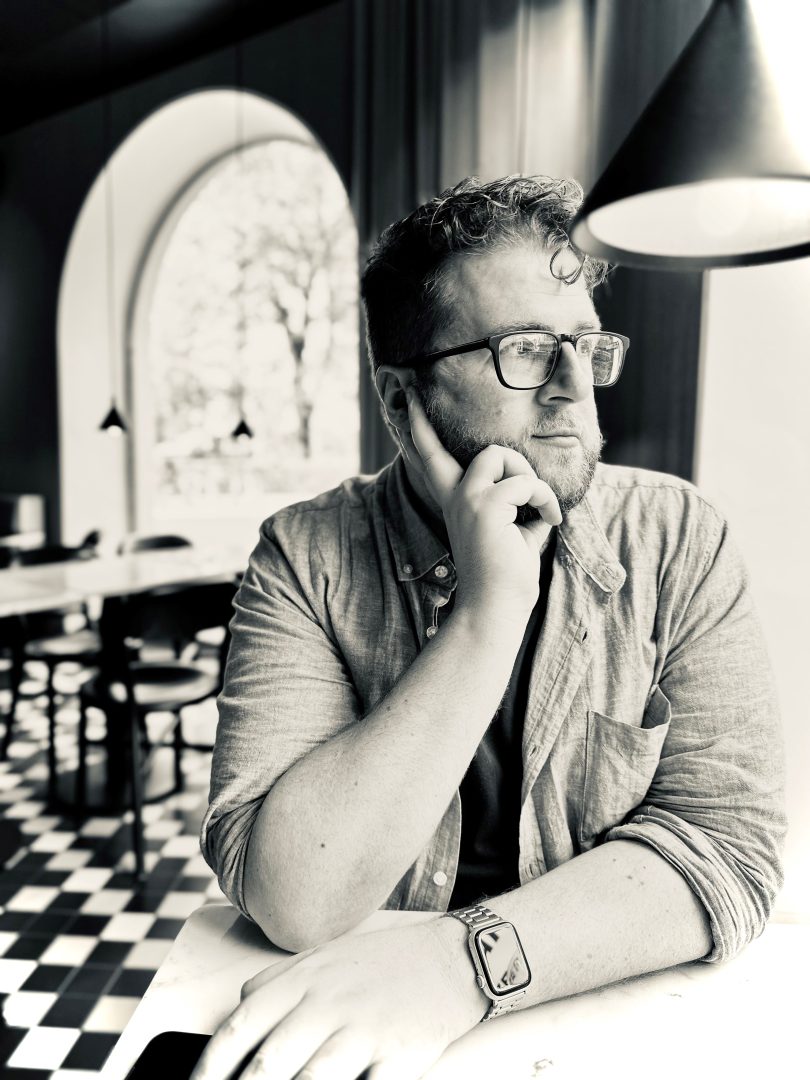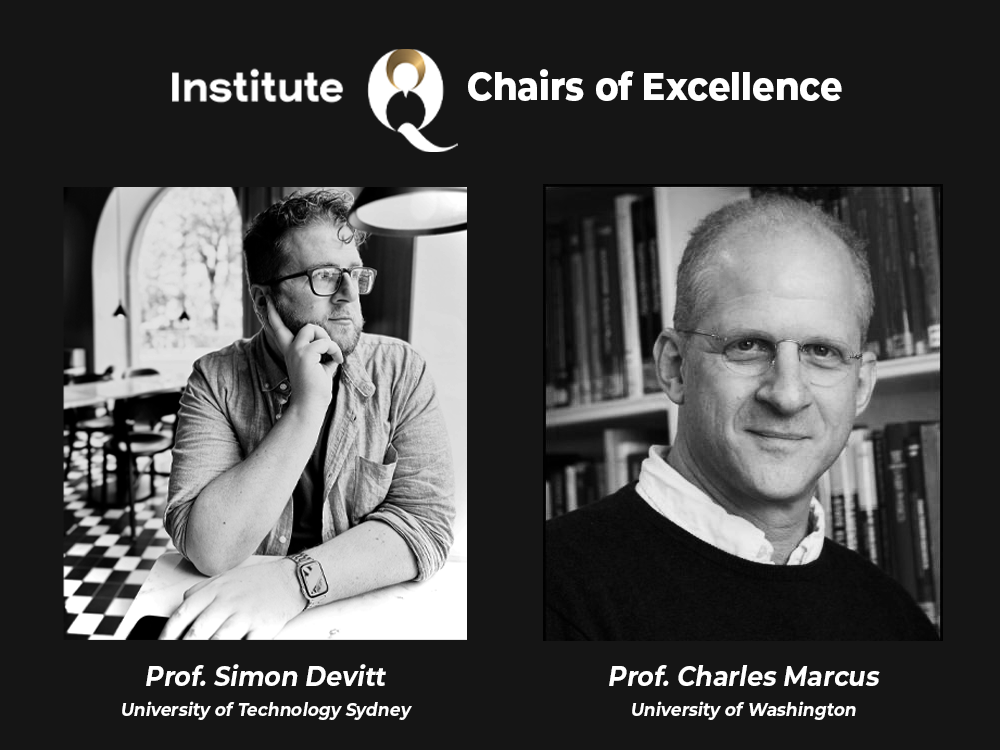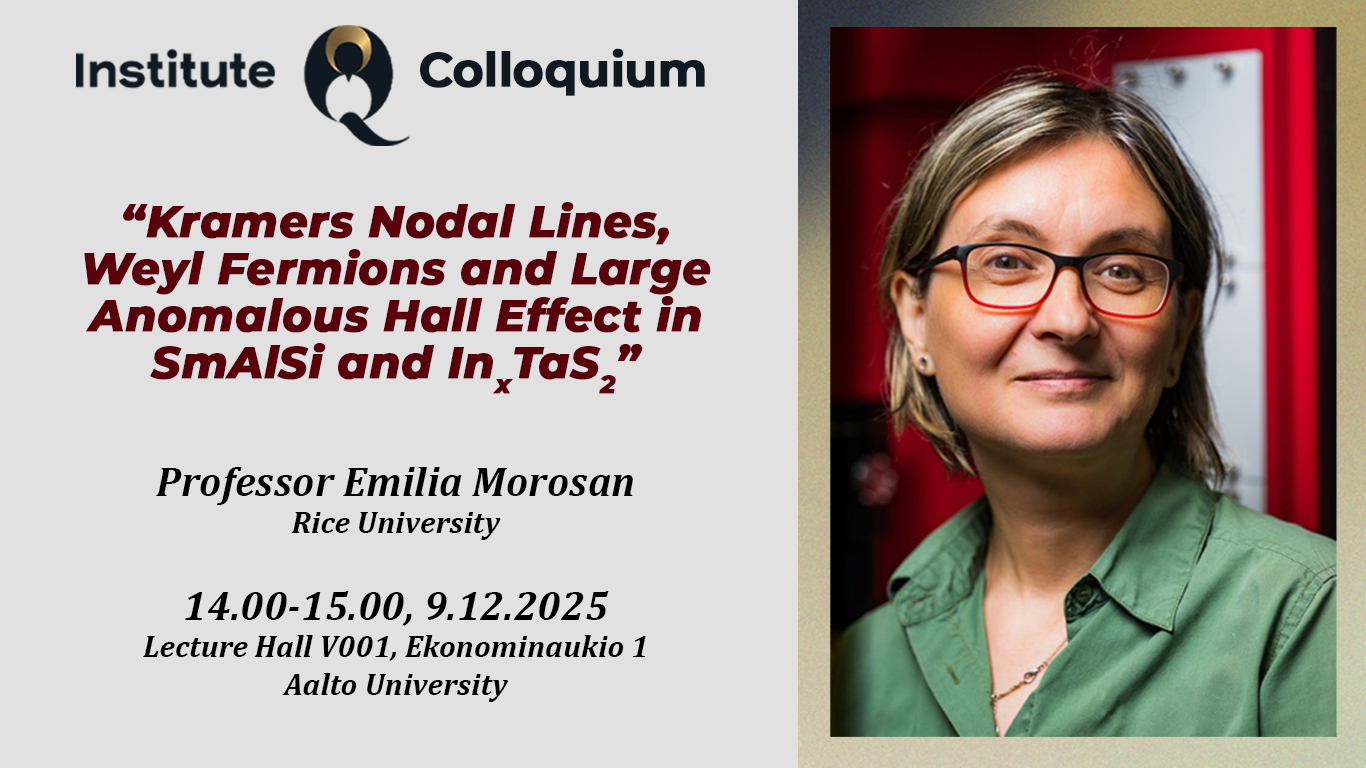Meet your InstituteQ Chairs of Excellence: Professors Simon Devitt & Charles Marcus
InstituteQ has selected Professors Simon Devitt and Charles Marcus to serve as Chairs of Excellence from 2023-25. InstituteQ began its selection process in 2022, and is pleased to announce the recruitment of these two distinguished professors. Read Q&A interviews with both Simon Devitt and Charles Marcus below.

Q&A with Simon Devitt
How did you come to learn about InstituteQ and the opportunity of the Chair of Excellence position?
I’ve been working with Alexandru Paler (Assistant Professor in the Aalto University Department of Computer Science) since he was a PhD student back in Germany. I have been aware of the Finnish quantum landscape, and I have been to Finland several times, including back in 2019, just before COVID hit when IQM was starting up.
But the motivation to apply for this was through my relationship with Alexandru and our continued collaboration, which is now a lot more solidified through our joint participation in the DARPA quantum benchmarking project.
But there’s also the broader strategic alignment that I think needs to be exploited between Sydney and Helsinki. There’s a lot of commonalities between the two respective ecosystems. Certainly, in terms of size, Finland has been pushing some of the larger quantum startups in the world. Not just IQM, but Bluefors and a few of the others.
The Finnish government seems to be pretty proactive in supporting the quantum ecosystem, which is something that I think the Australian government could probably learn a little bit more from considering how lackluster we’ve been compared to, quite frankly, a lot of countries in this area.
What utility do collaborative organizations like InstituteQ serve in the burgeoning field of quantum technology?
There has to be a little bit more engagement between smaller nations on this topic. Are we all just going to choose our side between the Chinese or the Americans and then hitch our wagon to one of them, and then just end up being the party suppliers and fourth-party participants in their national strategy?
We have to do something more. Look at what the White House has done in the last 12 or 18 months—they went like a freight train starting with Australia and Finland, the UK, then going through Sweden, Denmark, Norway, Switzerland, and it was all very US-centric. Why doesn’t Finland have a formal agreement with Australia? Why doesn’t Sweden have a formal agreement with Australia? Why doesn’t Finland have a formal agreement with Switzerland?
There’s a huge amount of work going on and a huge amount of talent. If you look at these so-called smaller nations like Finland, Australia, and Japan, we’re doing better work comparable to the amount of money that’s being invested.
The Americans are spending an absolute fortune, and they’re not lightyears ahead. We should be leveraging that kind of stuff, whether it’s InstituteQ here in Finland, or a similar model in Australia. Of course, we should have these collaboratives like InstituteQ, of course we should be providing these kinds of visiting fellowships that are very enticing and that foster collaboration.
This is a multi-decade, multitrillion dollar investment that’s going to be needed. Similar to Austrailia, everyone at the moment talks about being a part of the ecosystem, and being the world leaders of the field. But we’re too small. What you don’t want is just to be customers. You want to be in some way a critical part of the supply chain.
BlueFors is a good example. They have certainly positioned themselves to be the supplier of choice when it comes to cryogenics for quantum computing. That’s a great strategic place to put yourselves in. If that’s all Finland turns out to be in this game 20 or 30 years from now, that something like BlueFors is the standard when it comes to cryogenics for quantum computing, in my opinion, that’s a win for a country like Finland.
For the young student or researcher, what advice would you give for when they’re weighing their study options?
Scalability has always been a significant focus of research, whether it’s system design, architecture design, error correction, or fault tolerance. Nowadays, a lot of emphasis is placed on compilation strategies for resource estimation and performance analytics.
A lot of the current work in the field revolves around understanding the exact cost of running specific algorithms and finding ways to optimize these processes. From a theoretical perspective, these are the skills that will be highly sought after in the coming years. This trend is already visible to some extent.
Another area of theoretical demand pertains to quantum firmware, covering aspects like characterization, control, pulse optimization, and error mitigation techniques. These theoretical concepts are essential for improving the operation of qubits and are likely to remain highly desirable in the industry for the foreseeable future.
Looking ahead, I foresee a potential renaissance in the next five or six years, especially for solid-state quantum systems like superconductors or spins. This resurgence will likely benefit individuals who excel at ab initio modelling—meaning modelling from the ground up—of fabrication processes.
For instance, consider the current challenges in superconductors, where many fundamental error rate issues are related to material science. It’s not merely about control policies or the fundamental design of qubits. Instead, it involves the fabrication process, such as growing a superconducting circuit with Josephson junctions. Various factors can affect the yield and performance, including temperature, concentration, and more.
Being able to model these processes from the ground up and having skilled condensed matter theorists who can develop tools for this purpose will likely be in high demand as we push the boundaries of qubit capabilities and strive for consistently better error rates in the next few years. This will place significant importance on the fabrication process and the associated material science, with theoretical experts playing a critical role.
Q&A with Charles Marcus
How did you come to find out about the InstituteQ Chair of Excellence opportunity?
I’ve been associated with the University of Copenhagen since around 2009 when I came on sabbatical there. So I was already in Scandinavia by 2011 or 2012.
I had moved here and taken up a job at the Niels Bohr Institute, and at that time, I had funding from Microsoft Corporation, which had brought me into the area of superconductivity, not an area where I had worked before. Like anything new, there’s a learning curve to pick up the details of a new subject, even though it sounds adjacent to semiconductor physics and the condensed matter physics that I’d been involved with. But both with my new work in Copenhagen and my affiliation with Microsoft, I was spending more time thinking about superconductivity, even as a non-expert.
Jukka Pekola (Professor at the Aalto University Department of Applied Physics) is a well-known person. Through my Microsoft work and my research laboratory work at the Center for Quantum Devices in Copenhagen, I figured I would benefit from having someone who’s really an expert at quasiparticles and superconductivity. The kind of work Jukka did was something I needed to know more about.
My life diverted when I ended up leaving the Niels Bohr Institute and going back to Copenhagen to the university. So there were a lot of personal issues that affected our individual research lives, but it never really bothered our friendship.
At some point, Jukka asked, “Would you like to be considered for the InstituteQ professor?” My life was already a little bit busy and a little bit hectic with Copenhagen and the University of Washington on the horizon, but I thought I really like this friendship and I’m also somebody, like Jukka, who thinks better when I can do it with someone else.
I’m not a solitary thinker, and in all cases of my life in my career, I would say the best ideas that have emerged or the best results that I feel most happy about or thinking about happened with someone. It was the co-invention or the co-discovery or the co-realization, and in each of those cases, I used another person. So I think that it was a really natural thing for me to say yes to this InstituteQ offer.

How are collaborative organizations like InstituteQ useful, especially in a time when it seems like there are a lot of rapid advancements in the field?
Yeah, I would say I don’t see advancements being made any faster or slower than previously. I think that we are in a new era. I don’t personally think that the new era is characterized by incredibly rapid advancements. I think that it’s characterized by the entry of companies large and small, startups and major companies, including IQM, Microsoft, Google, IBM, and QDevil to name a few.
But one of the things that is important, I think, is that Aalto University was already engaged with VTT, which I had previous engagements with, and they had been very positive.
I saw that what InstituteQ did was try to work out a healthy relationship between professional science, professional engineering, and academic education-based science, and to get the distances right, to get the interaction right. It’s very difficult, but VTT and Aalto had made great strides in that direction.
I think that one of the things that InstituteQ can do is navigate this very difficult axis. It’s not difficult from a technological point of view; it’s difficult from a cultural point of view. It’s difficult because the goals of a company are different from the goals of the university. Even though the hardware or the ideas they consider can be very similar, especially in the realm of quantum technology, they are nonetheless aimed at different objectives. Those two have to be interlaced very carefully.
What I’ve seen in Finland, probably more so than anywhere else in the world, is a very thoughtful engagement between enterprises like VTT and universities. This is the key to the future of quantum technologies.
I think what InstituteQ is doing, in addition to exercising this axis between academic research and for-profit companies, is reaching out beyond Finland, and that’s new. That was not part of the equation before InstituteQ, as far as I could see, with the goals of Finland.
Now, the goals of Finland may be more about advancing the Finnish quantum landscape, but it does appear that there is a recognition through InstituteQ that internationalism is the route to national strength. That’s what I think InstituteQ is all about: enhancing the Finnish quantum landscape, not by isolating itself but by recognizing that bringing people here enhances the landscape. Not because of their personal contributions but because students, postdocs, and faculty get engaged in a better way when they see the whole world, not just their neighborhood. That’s the philosophy of InstituteQ that I strongly support.
In an effort to avoid some of the sensationalism surrounding quantum technology, how would you differentiate the importance between targeted research into quantum computing, for example, and fundamental research in the wider field of quantum mechanics?
I would have to say that we can’t make that distinction. We don’t know. The whole magic of basic research is that it does not divide into work that is useful and work that is not useful.
I assure you that Albert Einstein was not thinking about global positioning when he developed general relativity, but without general relativity, there would be no Global Positioning System.
On any given day, on any given idea, you cannot trace the thread forward to ask what technology will result from this seemingly unrelated idea. You cannot do it. You can pretend that you can go backward and say that this technology would not have emerged had a certain chain of events not happened. But I assure you that at the time those developments occurred, there was no clear forward thread.
Now, you can look in domains that are fertile. Semiconductors are fertile. Electronics are fertile. Lasers are fertile, more so than, say, string theory, or very abstract ideas in mathematics. But I spent 10 years working on very abstract ideas in mathematics that had manifested themselves as topological qubits.
The reason to engage in basic research is not as a respite or a counterpoint to applied research. It’s because one simply cannot trace threads forward from the discovery of an idea and the realization of a new truth to how that truth will be used.
So we can talk about quantum computing, and we can talk about all of the people who are contributing to quantum computing. It could be that the odds are slightly higher that somebody working on quantum computing will actually make a breakthrough relevant to quantum computing. But it may be not.
Those studies of exotic materials, layered materials, twisted materials, mixed materials are, I would say, the food for the future technologies that we have not imagined yet.
There, I’ve totally done away with the important distinction between exotic basic curiosity-driven exploration in a fertile area like electronic superconductivity, semiconductors, etc., and targeted application-based research like quantum computing. I don’t acknowledge the distinction.
What do you hope to accomplish and the time you are visiting professor in the Chair of Excellence position?
What I do is work with young people to maximize the probability that they have good ideas. That’s my job. Occasionally, I moonlight as a creative person, but my day job is to inspire creativity in others. In particular, younger people.
I think that there’s a couple of things that I hope to accomplish. The first is to the mutual benefit of Finnish scholars at all levels, from bachelor’s students to postdocs, even to professors, and American students, postdocs, and professors. To enhance the quality of their lives and the quality of their research by allowing a tunneling process between those two places, the United States and Finland, and through a kind of replication of the serendipity that I had in becoming friends with Jukka.
I also aim to enhance everybody’s experience and to act as a personal catalyst for finding engagement between two remote places and finding the discovery and co-discovery of new ideas that occurs with a much higher rate when new people from different backgrounds, both culturally and scientifically, share their ideas in a trusting way with each other.




